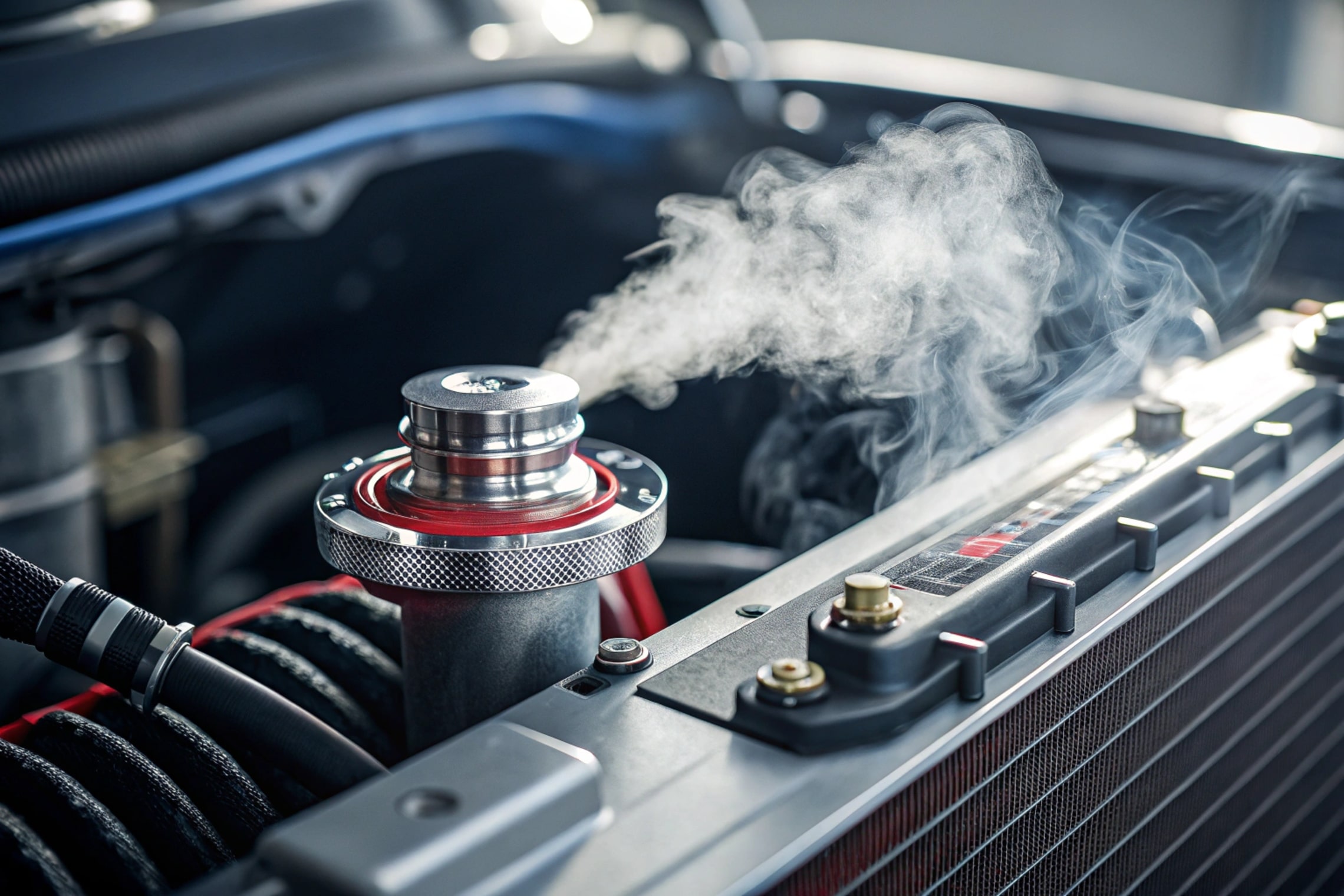A radiator with a cap plays a critical role in heating and cooling systems by maintaining pressure, managing coolant expansion, and preventing leaks. The cap seals the radiator, ensuring no air enters the system, which could disrupt heat exchange and cause overheating.
Whether you’re capping off a radiator temporarily or permanently, knowing its functions and proper handling is key. This guide explores types of radiator caps, their benefits, maintenance tips, and step-by-step solutions to help you keep your heating system running efficiently while avoiding common issues like leaks or pressure loss.
What is a Radiator with a Cap?
A radiator with a cap is an essential component of your heating or cooling system. The radiator cap plays a vital role in maintaining the system’s pressure, preventing coolant leaks, and ensuring optimal performance. It acts as a seal, keeping the coolant inside the radiator while allowing for expansion and contraction as the temperature changes.
Radiator caps are designed with a pressure relief valve and a vacuum valve. These features help regulate the system’s pressure, prevent overheating, and maintain the coolant level. Without a properly functioning radiator cap, your heating or cooling system could face serious issues, including leaks, airlocks, and inefficient heat exchange.
What is a Radiator with a Cap?
A radiator with a cap is a crucial component in heating and cooling systems. The cap seals the radiator, maintaining pressure and preventing coolant leaks. It also regulates coolant expansion and ensures efficient heat transfer. Without a properly functioning cap, the system can overheat, leak, or lose efficiency, leading to potential damage and higher maintenance costs.
Functions of a Radiator Cap:
The radiator cap performs key functions like maintaining system pressure, managing coolant expansion, and sealing the cooling system. It prevents air from entering, which can disrupt heat exchange. Additionally, it allows coolant to flow into the reservoir when heated and back into the radiator when cooled, ensuring optimal performance and preventing overheating.
Why is a Radiator Cap Important?
The radiator cap is more than just a cover for your radiator. It serves several critical functions:
- Pressure Regulation: The cap maintains the cooling system’s pressure, which raises the boiling point of the coolant. This prevents the coolant from boiling off and ensures efficient heat transfer.
- Coolant Expansion Management: As the coolant heats up, it expands. The radiator cap allows excess coolant to flow into the reservoir tank, accommodating this expansion.
- Sealing the System: The cap prevents air from entering the system, which can disrupt the heat exchange process and lead to overheating.
- Coolant Recovery: When the system cools down, the vacuum valve in the cap allows coolant to flow back from the reservoir tank to the radiator, maintaining the proper coolant level.
Types of Radiator Caps:
Not all radiator caps are the same. Depending on your system’s requirements, you may need a specific type of cap. Here are the most common types:
- Standard Radiator Caps: These basic caps maintain system pressure and seal the radiator. They are commonly used in residential heating systems and standard vehicles, ensuring efficient heat transfer and preventing coolant leaks.
- High-Pressure Radiator Caps: Designed for systems operating at higher pressures, these caps are ideal for performance vehicles or industrial heating systems. They handle increased pressure levels, preventing overheating and maintaining system stability.
- Blanking Radiator Caps: Also called blanking plugs, these caps seal radiator openings temporarily or permanently. They are used when a radiator is removed or not in use, preventing leaks and maintaining system integrity.
- Pressure-Relief Radiator Caps: These caps feature a pressure relief valve to prevent overpressurization. They automatically release excess pressure, protecting the system from damage while maintaining optimal pressure levels for efficient operation.
- Specialty Radiator Caps: Custom-designed for specific applications, these caps cater to unique system requirements. They are often used in high-performance or specialized heating systems, ensuring compatibility and reliable performance under demanding conditions.
Also read: What Is Jahizekosedos – The Ultimate Guide To This New Trend!
How to Cap Off a Radiator? – Permanent and Temporary Solutions!
Capping off a radiator is a common task when removing or replacing a radiator. Whether you need a temporary or permanent solution, here’s a step-by-step guide to help you through the process.
Permanent Capping Off:
- Turn Off the Heating System: Begin by switching off the heating system to ensure safety and prevent burns. This step is crucial to avoid hot water or steam escaping during the process.
- Isolate the Radiator: Close the valves at both ends of the radiator to disconnect it from the heating system. This prevents water from flowing into the radiator while you work.
- Drain the Radiator: Place a bucket or bowl beneath the radiator to catch water. Open the bleed valve to drain the radiator completely, ensuring no water remains inside.
- Remove the Radiator: Loosen the union nuts and carefully lift the radiator off the wall. Enlist help if needed, as radiators can be heavy and awkward to handle.
- Cap Off the Radiator: Hire a professional plumber to cap off the radiator and modify the pipework. This ensures a secure seal and prevents issues like “dead legs” in the system.
Temporary Capping Off:
- Turn Off the Heating System: Start by turning off the heating system to ensure safety and prevent water from flowing during the process.
- Drain the Radiator: Drain the radiator completely to avoid water leakage. Use a bucket or bowl to catch any remaining water.
- Clean the Pipe End: Remove any debris or dirt from the pipe end to ensure a proper seal when attaching the blanking cap.
- Apply Thread Seal Tape: Wrap the pipe threads with thread seal tape in a clockwise direction. This creates a tight, leak-proof seal for the blanking cap.
- Attach a Blanking Cap: Screw the blanking cap onto the pipe end securely, but avoid over-tightening to prevent damage. This temporary solution allows you to restore the radiator later.
Benefits of Using a Radiator with Cap:
A radiator with a cap ensures efficient system performance by maintaining pressure, preventing leaks, and managing coolant levels. It extends the system’s lifespan, reduces wear and tear, and prevents overheating. Properly sealed caps also improve energy efficiency, saving costs and protecting your home from water damage caused by leaks.
Prevents Leaks:
A well-sealed radiator cap prevents coolant leaks, safeguarding your floors and walls from water damage. Maintaining a tight seal ensures no water escapes, even under pressure, keeping your heating or cooling system reliable and your home damage-free.
Also read: Follxinyuhoi – A Powerful Meditation Technique For Stress Relief!
Maintains System Efficiency:
The radiator cap regulates pressure and coolant levels, ensuring optimal system performance. By maintaining the correct pressure, enhances heat transfer efficiency, reduces energy consumption, and keeps your heating or cooling system running smoothly.
Extends System Lifespan:
Proper pressure management by the radiator cap reduces stress on the system, minimizing wear and tear. This extends the lifespan of your heating or cooling system, saving you money on repairs and replacements in the long run.
Prevents Overheating:
The radiator cap helps maintain the correct operating temperature by regulating pressure and coolant flow. This prevents overheating, which can cause system damage, ensuring your heating or cooling system operates safely and efficiently.
How to Choose the Right Radiator Cap?
Choosing the right radiator cap is essential for your system’s efficiency and longevity. Start by ensuring the cap’s pressure rating matches your system’s requirements to avoid overpressurization or underperformance.
Opt for durable materials like brass or stainless steel for long-lasting performance. Check the cap’s compatibility with your radiator’s design and size to ensure a proper fit. Finally, choose reputable brands known for quality and reliability, as they offer better durability and performance, reducing the risk of leaks or system damage.
Also read: Reddandwhitemagz.Com – Your Source For Lifestyle, Trends, And Culture!
Common Issues with Radiator Caps:
Radiator caps, though essential, can cause problems if not maintained. Issues like leaks, incorrect pressure ratings, stuck caps, and air entering the system can disrupt performance. These problems lead to overheating, inefficient heat exchange, and potential system damage, underscoring the importance of regular inspections and timely replacements for optimal functionality.
Leaking Cap:
A leaking radiator cap, often due to wear or damage, results in coolant loss and overheating. Leaks can damage floors and walls while reducing system efficiency. Regular inspections and prompt replacement of faulty caps are necessary to prevent leaks and maintain the system’s reliability and performance.
Incorrect Pressure Rating:
Using a radiator cap with an incorrect pressure rating can cause overpressurization or underperformance. This imbalance leads to overheating, leaks, or inefficient heat transfer. Always ensure the cap’s pressure rating matches your system’s requirements to avoid these issues and maintain optimal performance.
Stuck Cap:
A stuck radiator cap, often caused by rust or debris, makes maintenance and coolant refills challenging. Regular cleaning and lubrication of the cap can prevent this issue, ensuring easy access for system checks and maintaining the smooth operation of your heating or cooling system.
Air in the System:
A faulty radiator cap can allow air to enter the system, disrupting heat exchange and causing overheating. Air pockets reduce efficiency and damage components. Replacing damaged caps promptly ensures proper sealing, preventing air entry and maintaining the system’s performance and longevity.
Maintenance Tips for Radiator Caps:
- Regular Inspections: Inspect the radiator cap periodically for signs of wear, such as cracks, rust, or damaged seals. Early detection of issues helps prevent leaks, overheating, and system inefficiency, ensuring long-term reliability.
- Clean the Cap: Remove dirt, debris, or buildup from the cap and its sealing surfaces. A clean cap ensures a proper seal, preventing leaks and maintaining optimal system pressure and performance.
- Replace When Necessary: If the cap shows damage, such as cracks or worn-out seals, replace it immediately. A faulty cap can lead to pressure loss, leaks, or overheating, compromising system efficiency.
- Test the Pressure: Use a pressure tester to check if the cap maintains the correct pressure rating. Regular testing ensures the cap functions properly, preventing system issues and extending its lifespan.
- Lubricate the Threads: Apply a small amount of lubricant to the cap’s threads to prevent sticking. This makes it easier to remove and reinstall the cap during maintenance, ensuring smooth operation.
Future Plan for Radiator Cap Maintenance:
To keep your radiator cap in optimal condition, develop a future maintenance plan. Conduct regular inspections every 6 months to identify wear like cracks or rust. Clean the cap and sealing surfaces seasonally to remove debris. Replace the cap every 2-3 years or when damage is noticed.
Use a pressure tester annually to ensure proper functionality. Lubricate the cap’s threads to avoid sticking. This proactive strategy will improve system efficiency, prevent leaks, and extend the lifespan of your heating or cooling system.
FAQS:
Can I use any radiator cap for my system?
No, radiator caps vary by pressure rating and design. Always choose one that matches your system’s specifications to ensure proper sealing, pressure regulation, and efficient performance. Using the wrong cap can lead to leaks or overheating.
How do I know if my radiator cap is failing?
Signs of failure include coolant leaks, overheating, low coolant levels, or difficulty opening the cap. Regular inspections and pressure tests can help detect issues early, preventing system damage and ensuring smooth operation.
What happens if I use the wrong pressure rating?
Using an incorrect pressure rating can cause overpressurization (leading to leaks) or underperformance (causing overheating). Always use a cap with the recommended pressure rating for your system to maintain efficiency and prevent damage.
Can I cap off a radiator without professional help?
Temporary capping can be done using a blanking cap and thread seal tape. However, for permanent capping or complex systems, consult a professional plumber to ensure proper installation and avoid potential issues like leaks or pressure loss.
Why does my radiator cap get stuck?
A stuck radiator cap is often caused by rust, debris, or lack of lubrication. Regular cleaning and applying lubricant to the threads can prevent this issue, ensuring smooth operation and easy access during maintenance.
Conclusion:
A radiator with a cap is an indispensable component of any heating or cooling system, ensuring efficient performance by maintaining pressure, preventing leaks, and managing coolant levels. A proper understanding of its functions, types, and maintenance can help you avoid common issues like overheating or system damage.
By following the guidelines outlined in this guide, you can ensure your radiator cap operates smoothly, extending the lifespan of your system and saving on costly repairs. Regular inspections, timely replacements, and proactive maintenance are key to keeping your heating or cooling system running efficiently for years to come.




